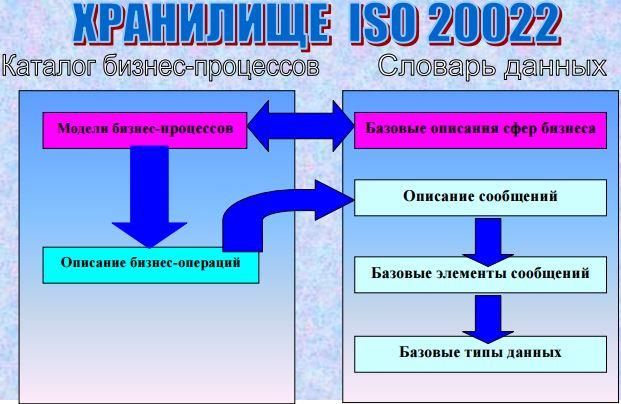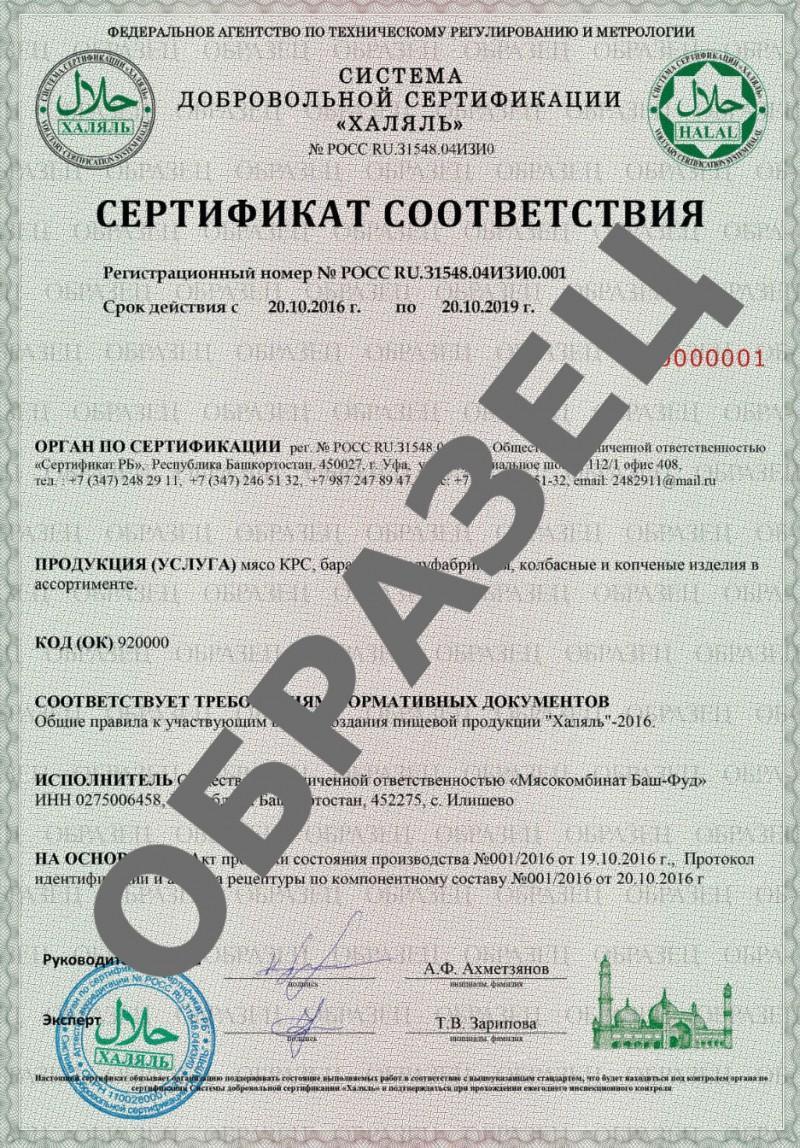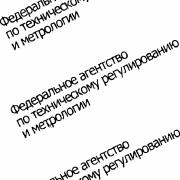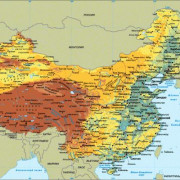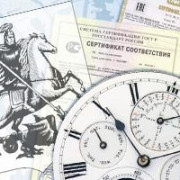Iso 50001
Содержание:
- Внедрение стандарта ГОСТ Р ИСО 50001:2012 Энергетического Менеджмента
- Актуальность энергосбережения
- Сертификат об окончании курса
- Development
- Certification
- Algunos Beneficios de ISO 50001
- Методология
- ISO 50001 and ISO 14001
- Стоимость сертификации и срок оформления в Санкт-Петербурге ИСО 50001
- INTERACION DE LOS SISTEMAS
- Background
- DISTINTO ENFOQUE
- Стандарт ISO 50001
- Разработка
- Impact
- Evaluando costes en ISO 50001
- Retorno de la inversión
- Structure
- Reasons for use
- Method
- Сроки и стоимость внедрения ISO 50001:2011/BS EN 16001:2009
- ISO 50001 Gestión de la Energía
- Сертификация ISO 50001
Внедрение стандарта ГОСТ Р ИСО 50001:2012 Энергетического Менеджмента
Ответить на вопрос, сколько стоит внедрение стандарта сразу нельзя, т.к. цена зависит от многих параметров.
Для внедрения системы нужно предоставить все сведения для аудита. Именно тщательная проверка позволит проанализировать данные, а затем создать предписания для более эффективного использования энергии на предприятии. При этом может потребоваться изменение освещения производственных цехов, переход на другие варианты отопления или модернизация оборудования. В каждом случае для ИСО 50001 – энергетический менеджмент имеет свои особенности. Поэтому о конечной стоимости можно узнать лишь после проведения консультации. Для этого позвоните по телефону 8 (800) 100-60-47 и наши эксперты предоставят всю необходимую информацию для дальнейшего сотрудничества.
Процесс внедрения не проходит единожды. Руководство компании постепенно приходит к пониманию того, что для успешного энергосбережения необходима постоянная модернизация. Сертификация ISO 50001 может быть проведена после трех месяцев внедрения системы. Тогда можно обратиться в центр, занимающийся выдачей сертификатов. К выбору данной организации следует подходить тщательно, так как для продолжительного сотрудничества нужны специалисты высокого класса, которые выполнят свою часть работы быстро и качественно. Центр, безусловно, должен иметь аккредитацию на ведение данной деятельности.
Актуальность энергосбережения
Одной из главных причин необходимости повышения энергоэффективности и энергосбережения является истощаемость природных ресурсов. В настоящее время ограниченность энергоресурсов, так или иначе, затрагивает все государства и становится проблемой глобального масштаба. Актуальность изменения отношения к энергоресурсам связана с высокой энергоёмкостью продукции. Эта проблема в свою очередь влечет за собой такие последствия как неэффективность экономики, неконкурентоспособность продукции, малая реализация на мировых и внутренних рынках, расходы на экспорт, закрытие малоэффективных предприятий и др.
Ещё одной важной причиной повышения энергоэффективности и энергосбережения является загрязнение окружающей среды, в частности, газы выделяемые в атмосферу при сжигании ископаемого углеводородного топлива способны вызывать парниковый эффект.
Внедрение системы энергоменеджмента позволяет решать эти проблемы.
Сертификат об окончании курса
Слушателям, выполнившим все задания для непрерывной оценки знаний и успешно прошедшим тест, будет выдан сертификат об окончании курса, отвечающий требованию о прохождении формального обучения к лицам, желающим получить сертификат аудитора или ведущего аудитора, зарегистрированного в CQI/IRCA. Для сертификации в качестве аудитора, зарегистрированного в CQI/IRCA, сертификат об успешном прохождении данного курса действителен в течение пяти лет с даты последнего дня обучения.
Слушатели, посетившие все занятия, но не выполнившие задания для непрерывной оценки знаний и не прошедшие тест, получат сертификат о посещении курса.
Development
The United Nations Industrial Development Organization (UNIDO) recognized that industry around the world needed to mount an effective response to climate change. It also noted a proliferation of national energy management standards that were emerging as a response to market demand for help with energy efficiency.
In April 2007, a UNIDO stakeholders meeting decided to ask ISO to develop an international energy management standard.
ISO for its part had identified energy management as one of its top five areas for the development of International Standards and, in 2008, created a project committee, ISO/PC 242, Energy management, to carry out the work.
ISO/PC 242 was led by ISO members for the United States (ANSI) and Brazil (ABNT). In addition, its leadership included the ISO members for China (SAC) and the United Kingdom (BSI Group) to ensure that developed and developing economies participated together in the project committee.
Experts from the national standards bodies of 44 ISO member countries participated and another 14 countries sent observers. Development organizations including UNIDO and the World Energy Council (WEC) were also involved.
ISO 50001 also drew on existing national and regional energy management codes and standards, including ones developed in China, Denmark, Ireland, Japan, Republic of Korea, Netherlands, Sweden, Thailand, the US and the European Union.
ISO 50001:2011 Energy management systems – Requirements with guidance for use was published on June 17, 2011.
ISO published a revised version of ISO 50001 in 2018. The revision reflects a desire to promote adoption of the standard among small and medium sized enterprises. It also incorporates ISO’s «high level structure» for use where organizations wish to integrate a number of management system standards together.
Certification
Certification proves that the energy management system meets the requirements of ISO 50001. This gives customers, stakeholders, employees and management more confidence that the organization is saving energy. It also helps to ensure that the energy management system is working throughout the organization.
Another advantage of a certification is its emphasis on continual improvement. The organization will continue to get better at managing its energy. Additional cost savings can be generated over several years. Furthermore, certifying an organization shows your public commitment to energy management.
UKAS, the certification bodies’ accreditation scheme in UK, accredits certification bodies to carry out certification of business energy management systems to ISO 50001. In July 2018, there were 15 UK bodies with the necessary accreditation to carry out independent audits and issue Energy Management Systems Certification to ISO 50001.
Algunos Beneficios de ISO 50001
Con la implantación de esta norma, cualquier empresa será capaz de adoptar los procesos para comprender su consumo de energía de base y así emprender acciones, planes y objetivos de eficiencia energética logrando la reducción de consumos.
Esta norma puede ayudar a cualquier tipo de organización, pública o privada, pequeñas o medianas empresas para ahorrar dinero en la energía actualmente desperdiciada.
Ahora bien, vamos a ver que nos aporta la norma con respecto a la simple implementación de medidas de cara al ahorro energético:
ISO 50001 pone en marcha un método sistemático para la gestión de proyectos de eficiencia energética dentro de una empresa, permitiéndonos establecer correctamente las prioridades, coordinando la aplicación de cualquier solución encaminada a la reducción del consumo de energía.
Las medidas a aplicar pueden ser de carácter técnico, tales como: optimización de tensión, variadores de velocidad para motores eléctricos, iluminación de bajo consumo, modernización de sistemas de calefacción y/o aire acondicionado etc. Sin embargo, ISO 50001 pretende ir más allá de soluciones puramente tecnológicas, que muchas empresas ya están optando, al proporcionar a la empresa una herramienta global para poner en práctica las medidas de ahorro energético y además:
- Fomentar y potenciar el uso eficiente de la energía por su personal
- Incluir todos los aspectos de la organización, identificando realmente las necesidades reales de cada empresa
- Fomenta la comunicación y sensibilización, promoviendo el cambio de cultura en el uso de la energía
Методология
Стандарт ISO 50001 содержит основные требования к организациям:
- разработка политики более результативного использования энергии;
- корректировка цели и задачи в соответствии с политикой;
- использование данных для более полного понимания того, как лучше использовать энергию, и для принятия соответствующих решений;
- измерение результатов;
- анализ того, насколько хорошо работает политика;
- постоянное улучшение энергетического менеджмента.
Стандарт основывается на методологии, известной как цикл по постоянному улучшению PDCA:
– планирование (plan) – проведение энергетического анализа и определение базовых критериев, показателей энергетической результативности, постановка целей, задач и разработка планов мероприятий, необходимых для достижения результатов, которые улучшат энергетическую результативность в соответствии с энергетической политикой организации;
– осуществление (do) – внедрение планов мероприятий в области энергетического менеджмента;
– проверка (check) – мониторинг и измерение процессов и ключевых характеристик операций, определяющих энергетическую результативность, в отношении реализации энергетической политики и достижения целей в области энергетики, и сообщение о результатах;
– действие (act) – принятие действий по постоянному улучшению результативности деятельности в области энергетики и системы энергетического менеджмента.
ISO 50001 and ISO 14001
ISO 50001 is data driven and focuses on energy performance improvement, while ISO 14001 provides a more qualitative look at all significant environmental impacts of an organization. Both standards can be implemented individually or they can be integrated with each other, or with any other ISO management system standards, such as ISO 9001.
If energy is an organization’s most significant environmental impact, ISO 50001 might be more appropriate than ISO 14001. Many organizations will manage energy successfully via ISO 14001, but especially in organizations where energy is a significant cost, ISO 50001 provides a more specific framework that enables organizations to apply a sharper focus to energy efficiency.
Стоимость сертификации и срок оформления в Санкт-Петербурге ИСО 50001
Получить сертификат ГОСТ Р ИСО 50001:2012 можно с внедрением и без внедрения
При оформлении без внедрения:
- Стоимость сертификата ISO 50001 составляет – 25 000 рублей
- Срок сертификации по стандарту ГОСТ Р ИСО 50001 (2012) – до 3-х дней
- Срок действия сертификата соответствия ГОСТ ИСО 50001 – 3 года
Компания получает полный пакет документов по стандарту ГОСТ Р ИСО 50001:
- Сертификат ИСО 50001 (Основной бланк)
- Два сертификата на внутренних аудиторов
- Разрешение на применение знака системы сертификации РосТестСтандарт
- Комплект базовой документации по стандарту ISO 50001
Полученная документация подходит для получения допуска СРО и участия в Государственных тендерах различного масштаба.
INTERACION DE LOS SISTEMAS
LA Norma ISO 50001 ha sido desarrollada con elementos comunes a la norma ISO 14001 (Sistema de Gestión Ambiental). Por tanto, quién ya cuenta con un sistema ISO 14001 (en general cualquier ISO) puede integrar fácilmente un sistema de ISO 50001 en las estructuras existentes.
Por ejemplo, tomando partes comunes diríamos que podemos integrar sin esfuerzo, dentro de los esquemas de la norma ISO 14001, los Sistemas de Gestión de Documentos, las actividades de Formación y comunicación etc. de la nueva norma.
La siguiente tabla mostramos los elementos de ambas normas Mostrando en Negrita aquellos apartados que son más o menos integrables de ambas normas y aquellos en Verde, que deben ser desarrollados por completo en la Norma ISO 50001:
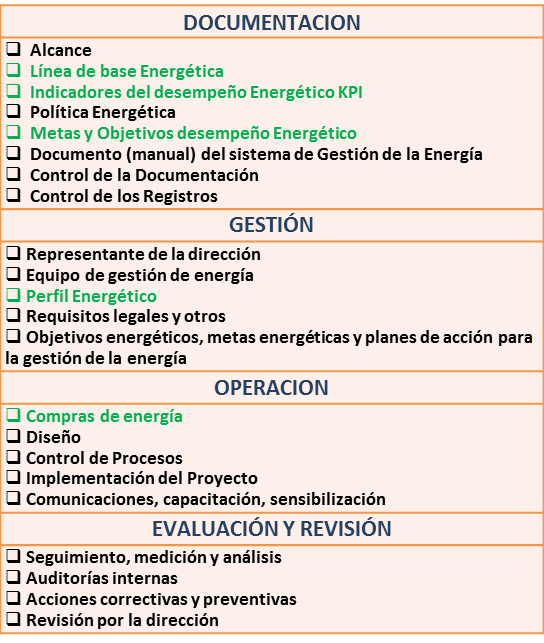
Haga AQUI su presupuesto Online ¡En 1 minuto!
Background
Organizations of all types and sizes increasingly want to reduce the amount of energy they consume. This is driven by the need or desire to:
- reduce costs,
- reduce the impact of rising costs,
- meet legislative or self-imposed carbon targets,
- reduce reliance on fossil fuels, and
- enhance the entity’s reputation as a socially responsible organization.
In tandem, governments increasingly want to reduce the Greenhouse Gas Emissions of their citizens and industries, and are imposing legislative mechanisms to compel carbon reduction more and more frequently.
In response, a range of energy management standards, specifications and regulations were developed in Australia, China, Denmark, France, Germany, Ireland, Japan, Republic of Korea, Netherlands, Singapore, Sweden, Taiwan, Thailand, New Zealand and the USA.
Subsequently, the European Committee for Standardization (CEN) developed EN 16001:2009 Energy management systems. Requirements with guidance for use as a first international energy management standard. This was published in July 2009 and withdrawn in April 2012 as it had been superseded by ISO 50001.
DISTINTO ENFOQUE
En principio, parecería que ambas normas tratan de lo mismo ya que finalmente se obtiene un resultado similar, en la reducción el impacto ambiental. Sin embargo, ambas normas tienen un enfoque muy distinto.
Mientras ISO 14001 se centra en resultado ambiental, la ISO 50001 establece un marco común para la gestión de la Energía, siendo la síntesis de la preocupación mundial por esta materia, que después de un largo trabajo que reunió a más de 60 países. El enfoque de esta norma es la optimización del consumo energético para conseguir ahorros de costes.
Lo nuevo en la Norma ISO 50001 es la consideración de los aspectos energéticos integrados en una metodología de actualización de la Energía, introduciendo conceptos novedosos como el consumo base de Energía o dedicando requisitos para la compra de materias primas y suministros de energía.
Стандарт ISO 50001
Стандарт ISO 50001 определяет следующие основные требования:
- идентификация всех, используемых топливно-энергетических ресурсов (ТЭР) и значимых потребителей энергоресурсов путем проведения тщательного и качественного энергетического обследования;
- соблюдение требований процессного подхода в управлении и определение показателей энергетической результативности процессов и значимых потребителей энергоресурсов;
- вовлечение в процесс энергоменеджмента персонала всех уровней. Повышение квалификации и компетентности в области возможных подходов экономии ТЭР и принципов наилучших производственных практик;
- идентификация внешних, внутренних, статистических, производственных и других переменных, влияющих на потребление ТЭР значимыми потребителями энергоресурсов и управление ими;
- идентификация производственных, управленческих и операционных процессов, результаты которых оказывают наибольшее влияние на потребление ТЭР с учетом законодательных и нормативных требований в том числе;
- организация эффективного учета используемых ТЭР у значимых потребителей;
- соблюдение принципа непрерывного улучшения путем разработки и выполнения мероприятий по результатам энергетического обследования и выполнения анализа потребления ТЭР значимыми потребителями.
Разработка
Основной предтечей стандарта ISO 50001 стали американский стандарт ANSI/MSE 2000:2008, корейский стандарт KS A 4000:2007 и стандарты ряда европейских стран в области энергоменеджмента (на основе которых был создан европейский стандарт EN 16001). Принятию стандарта ISO 50001 предшествовала скрупулёзная работа по анализу существующего опыта и принятию сбалансированных решений. В ходе обсуждений концепций национальных стандартов энергоменеджмента предпочтение было отдано американской модели, в которой имеется отражение достигнутого опыта других стран.
Основные этапы разработки стандарта:
Весна 2008 г. – США инициировано создание Технического комитета ИСО/ТК 242 «Energy Management», секретариат которого возглавил Американский Национальный Институт Стандартов (ANSI) и Бразильская Ассоциация технических норм (ABNT).
Сентябрь 2008 г. – 1-е пленарное заседание в Вашингтоне: делегаты из 25 стран мира, а также представители Организации ООН по промышленному развитию (UNIDO), представлен 1-й Рабочий проект (Working Draft, WD1).
Март 2009 г. – 2-е пленарное заседание в Рио-де-Жанейро: 73 делегата из 19 стран мира, на 21 стр. текста 2-го Рабочего проекта (WD2) объём предлагаемых поправок составил свыше 150 страниц.
Ноябрь 2009 г. — 3-е пленарное заседание в Лондоне: рекордное число комментариев – 754. Из них порядка 200 носили редакционный характер, 150 – общий характер, более 400 – технические замечания.
Октябрь 2010 г. – 4-е пленарное заседание в Пекине: Из более чем 40 стран, принявших участие в голосовании, 5 европейских стран (Франция, Великобритания, Германия, Италия и Испания) проголосовали «против» представленного проекта ISO/DIS 50001, что замедлило работу над текстом.
С марта по май 2011 г. – окончательное голосование по финальному проекту ISO/FDIS 50001: ни одного голоса не было подано «против» и лишь 2 страны воздержались.
Стандарт ISO 50001 был опубликован 15 июня 2011 года.
Второе издание стандарта 2018-08 — новая редакция ISO 50001:2018 отменяет и заменяет первое издание (ISO 50001:2011).
Impact
ISO reported that the standard was warmly received by the market when it was first published. To the end of January 2012, around 100 organizations in 26 countries had already achieved certification to ISO 50001. ISO also listed several users who had reported significant early cost savings and benefits.
In China, Delta Electronics, a provider of power and thermal management solutions, reported reducing power consumption by 10.51 million kWh as compared to the same period in 2010. This is equivalent to a reduction of 10.2 thousand tons of carbon emissions and a saving of CNY 8 million ($1.2m).
In India, the Dahanu Thermal Power Station in Maharashtra expected to accrue annual savings of about INR 96.4 million ($1.7m) from raised energy efficiency and management.
In Austria, the municipality of Bad Eisenkappel, with 2,400 inhabitants, expected its consumption of energy to be reduced by nearly 25 per cent, with the main savings achieved by updating the waste water plant and reducing energy consumption by 86 000 kWh, equivalent to €16,000 ($20.7k).
BSI Group published a case study showing that Sheffield Hallam University in the UK reduced its carbon emissions by 11 per cent once it was certified to ISO 50001. This yielded annual savings of over £100,000 ($160.7k).
In December 2013, the UK Department of Energy and Climate Change became the first Central Government department to achieve certification against the requirements of ISO 50001, leading by example with the belief that structured energy management will lead to substantial energy reductions and thus mitigate the effects of climate change.
ISO has stated that it believes in due course the standard could influence up to 60 per cent of the world’s energy use.
Evaluando costes en ISO 50001
Esta norma incide sobre aspectos totalmente tangibles para una empresa tales como
- La Energía una medida clave para las empresas.
- El ahorro de Energía significa ahorrar costos operativos.
- La reducción del consumo de Energía esta siempre relacionado con la reducción de emisiones de GEI acreditando el respeto por el medio ambiente.
- Cumplir con el desarrollo sostenible
“La Solución a la amortización de Costes de un Sistema de Gestión de la Energía”
Retorno de la inversión
Una diferencia notable de la implantación de esta norma con las demás nos viene del ahorro de costes que supone para una empresa:
- Costes directos de operación
- Costes indirectos (principalmente financieros)
Las experiencias de la empresas que ya han sabido ver las ventajas de esta norma, nos hablan de ahorros de hasta un 41% en los consumos energéticos por lo que concluimos que cualquier coste asociado a la implantación de sistemas que nos ayuden a gestionar la eficiencia energética, tendrá un retorno inmediato de la inversión realizada.
Structure
The structure of ISO 50001 is designed according to other ISO management system standards, in particular ISO 9001 (Quality Management Systems) and ISO 14001 (Environmental Management Systems). Since all three management systems standards are based on the PDCA cycle, and now share the same high level structure, ISO 50001 can be integrated easily to these systems.
There are ten major components to ISO 50001:2018:
- 1.: Scope
- 2.: Normative references
- 3.: Terms and definitions
- 4.: Context of the organization
- 5.: Leadership
- 6.: Planning
- 7.: Support
- 8.: Operation
- 9.: Performance Evaluation
- 10.: Improvement
Reasons for use
The main objective of the standard is to improve energy-related performance and energy efficiency continuously and to identify energy reduction opportunities. This systematic approach will help organizations to establish systems and processes.
Consistent energy management helps organizations to realize untapped energy efficiency potential. They will benefit from cost savings and make a significant contribution to environmental and climate protection, for example by the permanent reduction of CO2 emissions.
The standard should alert employees and in particular the management level to the immediate and long-term energy management gains that can be made. The organization can discover potential savings and competitive advantages. Furthermore, a huge image boost for the organization can be created.
Method
ISO 50001 provides a framework of requirements that help organizations to:
- develop a policy for more efficient use of energy
- fix targets and objectives to meet the policy
- use data to better understand and make decisions concerning energy use and consumption
- measure the results
- review the effectiveness of the policy and
- continually improve energy management.
ISO 50001 focuses on a continual improvement process to achieve the objectives related to the environmental performance of an organization (enterprise, service provider, administration, etc.). The process follows a plan – do – check – act approach.
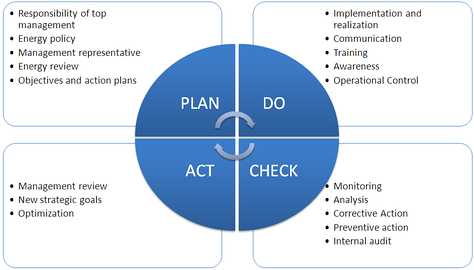
The 4 phases of the PDCA circle
Plan:
The overall responsibility for the installed energy management system must be located with the top management. An energy officer and an energy team should be appointed. Furthermore, the organization has to formulate the energy policy in form of a written statement which contains the intent and direction of energy policy. Energy policy must be communicated within the organization. The energy team is the connection between management and employees. In this phase the organization has to identify the significant energy uses and prioritize the opportunities for energy performance improvement.
Do:
The stated objectives and processes are now introduced and implemented. Resources are made available and responsibilities determined. Make sure that employees and other participants are aware of and capable of carrying out their energy management responsibilities. The realization of the energy management system starts.
Check:
An energy management system requires a process for compliance and valuation of energy-related regulations. Internal audit can help to verify that the energy management system is functioning properly and generating the planned results. The processes are monitored with regard to legal and other requirements (customer requirements, internal policies) as well as to the objectives of the energy management of the organization. The results are documented and reported to top management.
Act:
The top management prepares a written valuation based on the internal audit. This document is called the management review. The results will be evaluated on their performance level. If necessary, corrective or preventive actions can be initiated. Energy-relevant processes are optimized and new strategic goals are derived.
Сроки и стоимость внедрения ISO 50001:2011/BS EN 16001:2009
| Количество человек в компании | Срок | Стоимость |
|---|---|---|
| До 50 человек в компании | 3 месяца | 250 000 рублей |
| До 120 человек в компании | 3 месяца | 320 000 рублей |
| До 300 человек в компании | 4 месяца | 475 000 рублей |
| Выше 300 человек в компании | Уточнить у менеджера | Уточнить у менеджера |
Схема работы с нами
1
Подача заявки
2
Консультация от эксперта
3
Подготовка договора и документов
4
Оплата услуг
5
Получение документа
Отзывы наших клиентов
НАША КОМПАНИЯ УЖЕ 9 ЛЕТ НА РЫНКЕ и за это время
помогла заработать нашим клиентам БОЛЕЕ 825 МЛН.РУБ.
Все клиенты
Все отзывы
КОНСУЛЬТАЦИЯ ЭКСПЕРТА
Режим работы: с 09:00 до 18:00, в пятницу до 17:30
Онлайн заказы в выходные дни будут обработаны в первую очередь в понедельник утром
ISO 50001 Gestión de la Energía
ISO 50001:2011 es una normativa Internacional de reciente publicación, desarrollada por ISO (International Organization for Standardization) en el que se determinan los requisitos para la gestión de la energía en una organización
Haga AQUI su presupuesto Online ¡En 1 minuto!
Esta norma es de aplicación en todo tipo de empresas y organizaciones independientemente de su tamaño o actividad.
El objetivo principal de esta Norma es integrar la Gestión de la energía en todos sus aspectos, dentro de una organización con el sistema de Gestión de la Empresa, abarcando desde la compra de energía y materias primas hasta las medidas a adoptar en la empresa para promover el ahorro energético.
Como todas las Normas ISO de reciente creación, promueven además la integración de la Gestión de la Energía con los demás sistemas de gestión existentes, ya sean de gestión de Calidad (ISO 9001) como sistemas de gestión medioambiental ISO 14001 u otros.
Por otro lado, la sistematización de los procesos de gestión de la energía, instaurados por el SGEN (Sistema de Gestión de la Energía) la Norma ISO 50001 nos garantiza eficiencia de las medidas adoptadas, con los paradigmas comunes de las normas ISO: Responsabilidad de la dirección, comunicación y participación de todos las partes de la empresa, planificación de objetivos, puesta en marcha de los planes y finalmente con la revisión y me jora continua del sistema.
Para garantizar los objetivos la Norma se estructura de la siguiente forma:

ISO 50001 Sistema de Gestión de la Energía
Сертификация ISO 50001
Сертификация ISO 50001- это оценка способности организаций управлять процессами и деятельностью с целью повышения энергоэффективности своей деятельности. Международный стандарт ISO 50001 применим для любых организаций вне зависимости от их сфер деятельности.
Как получить сертификат ISO 50001?
- Внедрить требования международного стандарта ISO 50001
- Обратиться в ТМС РУС, чтобы получить сертификат ISO 50001

Если энергетический менеджмент согласно ISO 50001 подтвержден, то компания получает международный сертификат ISO 50001. Сертификат ISO 50001 выдается на 3 года, в течение срока действия сертификата, то есть через 12 и 24 месяцев после сертификационного аудита проводится ежегодный наблюдательный аудит, который подтверждает, что требования международного стандарта ISO 50001 выполняются. и система энергетического менеджмента поддерживается сертифицированной организацией.

